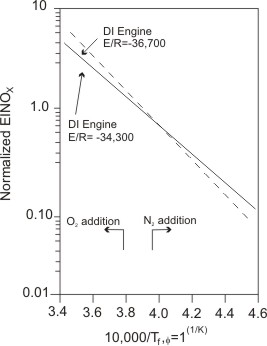Contd...
temperature. The measured NOx emissions with varying amounts of diluents at different engine loads and speeds correlated well with  according to the relationship given in Eq. 2.23 . On a log plot, the (EINOx) data normalized with emissions obtained for standard air (without diluents) for several engines had linear correlation with the reciprocal of according to the relationship given in Eq. 2.23 . On a log plot, the (EINOx) data normalized with emissions obtained for standard air (without diluents) for several engines had linear correlation with the reciprocal of  as shown on Fig 2.9. The activation energy for DI engine was determined to be - 285.0 kJ/gmol, and for IDI engines equal to - 304.9 kJ/gmol. A single value of E correlated the emission data varying by a factor of nearly 40 times. The good correlation obtained between EINOx and as shown on Fig 2.9. The activation energy for DI engine was determined to be - 285.0 kJ/gmol, and for IDI engines equal to - 304.9 kJ/gmol. A single value of E correlated the emission data varying by a factor of nearly 40 times. The good correlation obtained between EINOx and  demonstrates the dominant importance of NO formation in close-to-stoichiometric burned gas regions. demonstrates the dominant importance of NO formation in close-to-stoichiometric burned gas regions.

Figure 2.9 |
Correlation of NOx emission index with adiabatic flame temperature of stoichiometric mixture ( ) varied by addition of nitrogen and oxygen as diluents and determined for mixture conditions at top dead centre for motored engines [14]. ) varied by addition of nitrogen and oxygen as diluents and determined for mixture conditions at top dead centre for motored engines [14]. |
The engine design and operating conditions too affect the NOx formation process. The above model is a very simple model and it showed good correlation for the engines of 1980s. For advanced engines with very different injection parameters and fuel-air mixing processes, single overall activation energy was found to have a poorer correlation than shown on Fig. 2.9.
|